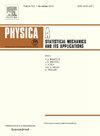IF 2.8
3区 物理与天体物理
Q2 PHYSICS, MULTIDISCIPLINARY
Physica A: Statistical Mechanics and its Applications
Pub Date : 2025-02-16
DOI:10.1016/j.physa.2025.130434
引用次数: 0
摘要
福克-普朗克-科尔莫戈罗夫(FPK)方程为描述概率密度函数(PDF)的演变提供了一个确定性框架,在随机动力学领域具有重要意义。物理信息神经网络(PINNs)的发展为求解 FPK 方程提供了一种新方法。然而,在处理解具有高频率的强非线性项的 FPK 方程时,采用均匀采样的普通 PINNs 方法面临挑战。在本研究中,我们引入了专门用于求解静态 FPK 方程的混合采样 PINNs。所提议的混合采样专门引入了轨迹残差点,并将其与基于方程残差的残差点自适应采样相结合。此外,该网络还采用了定制架构和损失函数,以应对与求解静态 FPK 方程相关的挑战和特定要求。我们将所提出的混合采样方法应用于三个非线性系统,通过与拉丁超立方采样 (LHS)、自适应采样和轨迹采样的比较,证明了该方法的准确性和高效性。分析了非线性参数对不同采样方法性能的影响,强调了混合采样法在涉及显著非线性的情况下所取得的卓越精度。这些实验结果表明,结合轨迹残差点可显著提高计算性能和精度。此外,我们还分析了不同轨迹点和自适应点对网络训练的影响,并研究了学习率策略对所提方法性能的影响。本文章由计算机程序翻译,如有差异,请以英文原文为准。
Physics-Informed Neural Networks with hybrid sampling for stationary Fokker–Planck–Kolmogorov Equation
The Fokker–Planck–Kolmogorov (FPK) equation provides a deterministic framework for describing the evolution of probability density functions (PDF) and holds great significance in the field of stochastic dynamics. Physics-Informed Neural Networks (PINNs) development provides a new approach for solving the FPK equation. However, the vanilla PINNs method with uniform sampling faces challenges when dealing with FPK equations with strong nonlinear terms whose solutions have high frequency. In this study, we introduce PINNs with hybrid sampling specifically designed to solve the stationary FPK equation. The proposed hybrid sampling specifically introduces trajectory residual points and combines them with an adaptive sampling of residual points based on the residuals of the equation. In addition, the network incorporates a customized architecture and loss function tailored to address the challenges and specific requirements associated with solving the stationary FPK equation. We apply the proposed hybrid sampling method to three nonlinear systems, demonstrating its accuracy and efficiency by comparing it with Latin hypercube sampling (LHS), adaptive sampling, and trajectory sampling. The impact of the nonlinear parameters on the performance of different sampling methods is analyzed, emphasizing the superior accuracy achieved by hybrid sampling in cases involving significant nonlinearity. These experimental results demonstrate that incorporating trajectory residual points notably enhances computational performance and precision. Furthermore, we analyze the impact of different trajectory points and adaptive points on network training and examine the effect of the learning rate strategy on the performance of the proposed method.
求助全文
通过发布文献求助,成功后即可免费获取论文全文。
去求助
来源期刊
CiteScore
7.20
自引率
9.10%
发文量
852
审稿时长
6.6 months
期刊介绍:
Physica A: Statistical Mechanics and its Applications
Recognized by the European Physical Society
Physica A publishes research in the field of statistical mechanics and its applications.
Statistical mechanics sets out to explain the behaviour of macroscopic systems by studying the statistical properties of their microscopic constituents.
Applications of the techniques of statistical mechanics are widespread, and include: applications to physical systems such as solids, liquids and gases; applications to chemical and biological systems (colloids, interfaces, complex fluids, polymers and biopolymers, cell physics); and other interdisciplinary applications to for instance biological, economical and sociological systems.

 求助内容:
求助内容: 应助结果提醒方式:
应助结果提醒方式:


